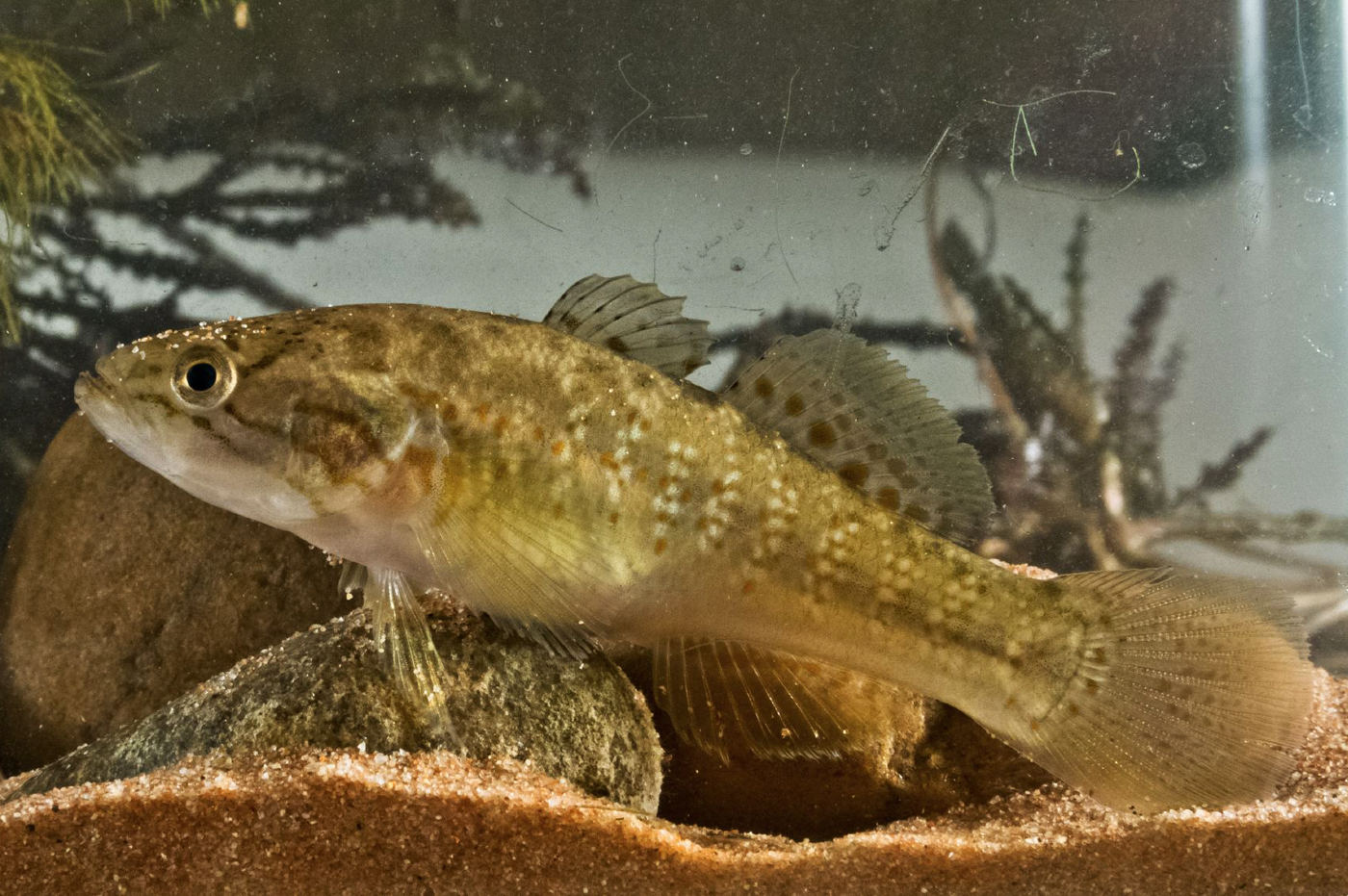- Classification
- ACTINOPTERYGII
- PERCIFORMES
- ELEOTRIDAE
- Mogurnda
- larapintae
Desert Mogurnda, Mogurnda larapintae (Zietz 1896)

A Desert Mogurnda, Mogurnda larapintae, from the Finke River on Henbury Station, Northern Territory, May 2013. Source: Robert Whyte / Flickr. License: CC by Attribution-NonCommercial-NoDerivatives
Desert Mogurnda, Mogurnda larapintae (Zietz 1896)
More Info
|
Distribution |
Known only from the Finke River System, NT; inhabits permanent freshwater, rocky waterholes. |
|
Features |
Meristic features: Dorsal fin VIII-IX + I, 10-14; Anal fin I, 9-12; Caudal fin (segmented rays) 15, (branched rays) 14-15; Pectoral fin 14-16; Pelvic fin I, 5; Transverse scales 14-17; Vertebrae 15-16 + 16-17 = 32-33. Body elongate, laterally compressed, more strongly posteriorly; body depth at pelvic fin origin 18.0-29.0% SL, body depth at anal fin origin 18.0-27.1% SL, head length 27.1-37.5% SL, snout length 5.6-9.9% SL, eye diameter 5.4-11.0% SL; caudal peduncle relatively elongate, length 20.4-26.3% SL, depth 12.7-22.0% SL. Head bluntly rounded with gently arched snout and nape profile; Lower jaw protruding, mouth oblique, reaching to anterior edge of pupil; jaws with villiform, posteriorly curved teeth, in dense bands, outer row enlarged; palate without teeth. Gill opening extending nearly to below rear margin of eye. Sensory pores absent on head, but well developed system of papillae arranged in multiserial bands. Sexual dimorphism generally inconspicuous. Head and body covered with scales, except lips, snout tip, preorbital region, lower jaw, and chin; those on head, predorsal region, breast, uppermost part of back and bases of caudal and pectoral fins cycloid, remainder finely ctenoid; lateral line absent; longitudinal series 38-45; predorsal scales 22-27; transverse scales 14-17(usually 15). Two dorsal fins, first rounded and lower than second, with slender, flexible spines; second dorsal and anal fins similar and opposite. Pectoral fin rounded, length 17.7- 27.0% SL. Pelvic fins separate, pointed, length 12.9-22.4% SL. Caudal fin rounded, length 24.6-37.2% SL. |
|
Size |
To around 13 cm SL. |
|
Colour |
Brown to mauve above grading to tan or whitish ventrally, with 10-11 narrow bars formed by partly fused, yellowish to cream spots; adults with many small reddish spots scattered on sides; side directly behind pectoral fins, including upper belly, yellowish; upper back and dorsal surface of head mottled with pale and darker brown; head with three reddish-brown diagonal stripes, third across middle of operculum and onto middle of pectoral fin base; pale areas between stripes creamy yellow; 1-2 short diagonal stripes from upper rear corner of eye. Dorsal, anal and caudal fins greyish to dusky yellow-brown; dorsal fins with darker submarginal band and dark brown speckling medially, second dorsal with narrow white margin and mauve basal stripe superimposed with 4-5 small red-brown spots; anal fin yellow brown with narrow white margin, blackish submarginal band, and broad, mauve basal stripe superimposed with 4-5 large, red-brown spots; pelvic fins dusky grey to whitish; pectoral fins semi-translucent with dusky brown fin-rays, usually with brownish bar across upper two-thirds of base. |
|
Feeding |
Likely to feed on insect larvae, small crustaceans and small fishes. |
|
Biology |
Oviparous, benthic spawners depositing adhesive eggs onto a hard substrate. Male guards the eggs until hatching. |
|
Remarks |
Formerly thought to be the same as M. mogurnda. |
|
Species Citation |
Eleotris larapintae Zietz 1896, in Spencer (ed.) Report on the Work of the Horn Scientific Expedition to Central Australia. Part 2. Zoology: 179, pl. 16(4). Type locality: Central Australia. |
|
Author |
Gomon, M.F. & Bray, D.J. 2018 |
|
Resources |
Desert Mogurnda, Mogurnda larapintae (Zietz 1896)
References
Adams, M., Page, T.J., Hurwood, D.A. & Hughes. J.M. 2013. A molecular assessment of species boundaries and phylogenetic affinities in Mogurnda (Eleotridae): a case study of cryptic biodiversity in the Australian freshwater fishes. Marine and Freshwater Research 64(10): 920-931. http://dx.doi.org/10.1071/MF12237
Allen, G.R. & Jenkins, A.P. 1999. A review of the Australian freshwater gudgeons, genus Mogurnda (Eleotridae) with descriptions of three new species. Aqua, Journal of Ichthyology and Aquatic Biology 3(4): 141-155
Allen, G.R., Midgley, S.H. & Allen, M. (2002). Field Guide to the Freshwater Fishes of Australia. Perth : Western Australian Museum 394 pp.



